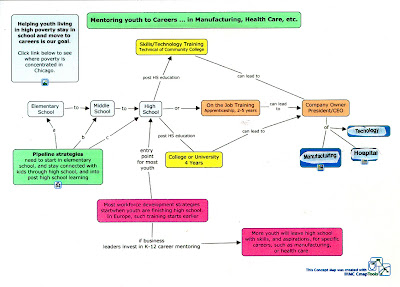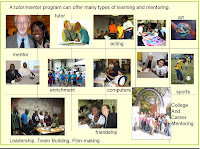Last night as I took the Blue Line to an event in Chicago I read through my current issue of Forbes.com. I found a story titled "The Dream Factory" which showed how Georgia-based Southwire set up a vocational education program for troubled teens. I ripped this story from the magazine and stuffed it into my pocket, aiming to look it up today.
The event I attended was hosted by members of the insurance industry, to give recognition and raise money for a program called InVEST, which provides financial literacy training in public schools.
During the reception I looked for a place to sit and found an older African American man with a great seat by the window. We introduced ourselves and he told me he was superintendent for a school in Milwaukee, with goals of keeping kids in school, reducing violence, and preparing kids for careers. I pulled the Forbes article from my pocket and encouraged him to read it, saying "if we can get the business community strategically involved, we can solve many of our problems".
Today as I browsed my Wall Street Journal, I found another article about this company in Georgia, under the headline "Factory Helps Teens Get Diplomas". I said to myself, if two high profile business publications are giving attention to this, maybe more business leaders will be motivated to try to build similar solutions.
A commitment to business involvement in pulling kids through school and into careers is not a new issue for me. You can see in both of the graphics I've used the role of business volunteers, dollars, technology, ideas and jobs reaching youth at early age then providing age-appropritate mentoring to help youth through high school, then college or vocational training, then into jobs.
This is another graphic I've used for a long time. The hub of this wheel is a youth, and the program that connects a youth with volunteers and a wide range of career opportunities. Such programs need to be located in many places, especially in high poverty neighborhoods where the diversity of adults working in different careers is limited.
As I said, I've been interested in vocational education for many years. One of the books I read in the 1990s, was "Rethinking America" by Hedrick Smith. He showed the same lessons that Southwire is demonstrating. For many young people the job provides the reason to learn math, science and better reading skills. Too many schools that focus on college as the only track don't provide this opportunity for a large number of their students.
I think about ideas like this as a result of becoming a mentor to a 4th grade inner city boy in 1973 through a program organized by employee volunteers at the Montgomery Ward Headquarters in Chicago. I became the volunteer leader of the program in 1975 and continued in that role until 1990 when I left the company and converted the program to a non profit, where I became its first full-time paid executive directory. In 1992 I created a new version of the original program, aimed at helping youth from 7th grade through high school, and led that till 2011. I created the Tutor/Mentor Connection in 1993 to mimic what the corporate office at Wards was doing to support 400 stores all over the country. My goal was to provide better support to all of the non-school tutor/mentor programs in Chicago.
If I had not been involved for so many years, I would not be looking at articles like these and would not be writing a blog encouraging others to become volunteers, then carry these ideas about vocational education and strategic business involvement back to your business.
This blog is organized into sections, so if you view the list on the left side, you can see article written about workforce development, violence, complex problems, etc. Consider this a learning resource for developing stronger tutor/mentor programs and for developing more and better vocational education programs involving businesses in your community.
If you're looking for a place to volunteer, here's my list of Chicago area youth serving organizations. It's organized by sections of the city and suburbs, so you can look for programs close to where you live or work, or on the route that you travel between home and work. In some parts of the region you have multiple choices. In others there are few choices. Some programs are well developed. Some need a lot of help to be well developed. Many need help with financial management. Most need help finding money to manage!
This graphic illustrates that every tutor/mentor program could have a broad range of volunteers and a broad range of learning experiences. Here's a pdf that illustrates this idea and shows how company teams, or volunteers from an industry sector, could take on a role of "virtual corporate office" to help mentor-rich programs grow in more places.
I've written many articles that leaders can use to build and sustain mentor-rich programs and strategies. I hope today's attention in Forbes and The Wall Street Journal will encourage companies to form research teams who will begin reading and reflecting on these ideas.
8-14-2020 update - I've known Dr. Edward Gordon of Imperial Consulting Corporation since late 1990s. His web site contains a wealth of ideas focusing on the connection of school and work. This link points to periodic articles he shares.
Friday, August 08, 2014
Subscribe to:
Post Comments (Atom)













No comments:
Post a Comment